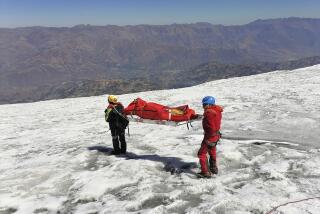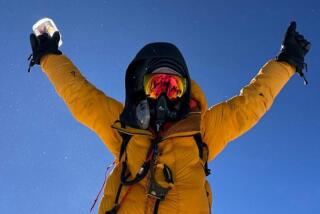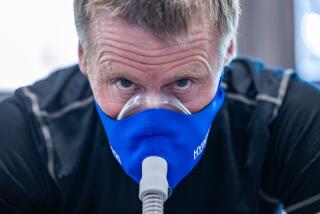Because They’re There
- Share via
Until recently there was no four-minute mile in mountain climbing. Climbing standards are far more subjective than track standards. A climb up a rock face on a warm, sunny day can be a lark. In a blizzard the standard of achievement on the same face could be survival.
Many climbers insist that mountaineering is not a competitive sport like running. George Leigh-Mallory said, most likely with a wink, that he wanted to climb Mt. Everest “because it’s there.” It is not a spectator sport. Still, climbers compete. First ascents of mountains are coveted. After that come first ascents of increasingly difficult routes, first winter ascents and first solo ascents. Reinhold Messner was the first to climb Everest solo--without oxygen.
In the Alps the great north faces have been the standards over the years. The first ascents before and after World War II of some of the longer and more demanding routes took days. It was years before anyone dared do one alone, although some mountaineers promoted the theory that there was safety in climbing fast and that the fastest climbers were those who ventured onto the peaks alone. Americans who mastered the rock walls of Yosemite Valley in California have helped push back the frontiers in the Alps and Himalayas.
Today there is an incredible standard that certainly comes close to the climbing equivalent of the four-minute mile: 24-year-old Christophe Profit of Chamonix, France, climbed the three great north faces of Europe--the Matterhorn, the Eiger and the Grandes Jorasses--in a single day. That is an accumulation of 13,000 vertical feet of some of the most demanding rock and ice terrain anywhere.
Profit started at the foot of the Matterhorn at midnight and reached the summit at 4 a.m. on July 24 (climbing news often travels slowly). He descended to the Hornli hut for a helicopter pickup and flight to the foot of the Eiger, which he climbed in seven hours in spite of unusually difficult ice conditions. Another helicopter hop took him to the Grandes Jorasses near Mt. Blanc in France, and he reached the summit of the Shroud route at 11:30 p.m. Famous French climber Rene Desmaison took nine days in making the first ascent of the Shroud in 1968.
Profit probably is not a significantly greater athlete than Desmaison was at the time. His equipment certainly is lighter and more sophisticated, but that does not account for a disparity of four hours and nine days. Profit’s achievement, in fact, is a matter of the mind as much as the physique. Other climbers, of course, now will seek ways to best it.
More to Read
Sign up for The Wild
We’ll help you find the best places to hike, bike and run, as well as the perfect silent spots for meditation and yoga.
You may occasionally receive promotional content from the Los Angeles Times.






